
Male modeling is a coveted career. Though attractiveness is not always quantifiable, there are definitely trends among successful male models that can serve as guides. These trends change over time, and so does any analysis of ideal male model characteristics. It is essential to take the culture and time period into context when analyzing male model characteristics.
Male model characteristics include a generally well-proportioned body, narrow hips, and low body fat. The ideal male model height is from 5’9 to 6’2. Facial characteristics should include prominent jaw and cheekbones, hunter eyes, balanced features, and clear skin.
What is ideal in a male model is a debatable topic. Standards of beauty and attractiveness change a lot over time. Today, the characteristics of male models are not always firmly rooted in masculinity. The ideals of male models are continuously evolving and diversifying.
The ideal male model also depends on the kind of modeling in question. With runway modeling, they prefer male models on the more slender side as they fit the collection’s clothes better. On the other hand, editorial models are more likely to be muscular and exhibit traditionally masculine traits.
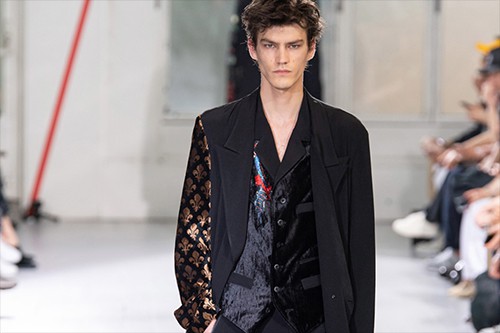
In the above photo, the male model is quite slender and has quite a youthful build.
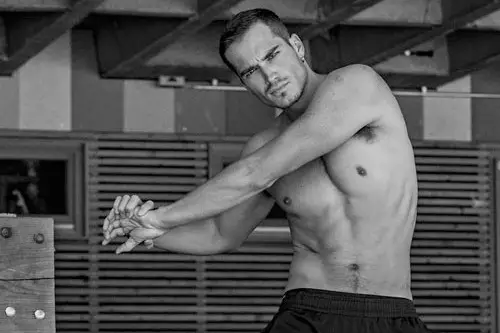
This editorial photo exhibits a more muscular body type.
Though male model body types vary throughout different developing niches, there are many common denominators in their appearance. For example, in both of these photos, a prominent jawline seems to be part of the appeal. Chiseled and hollowed-out cheekbones are present in both of the images.
Masculinity
Masculinity relies on social perceptions just as much as it does on physical traits. Masculine features are more aggressive and sharp than feminine features. Particular examples of these are a chiseled jawline and a strong chin. These characteristics are often associated with strength and authority.
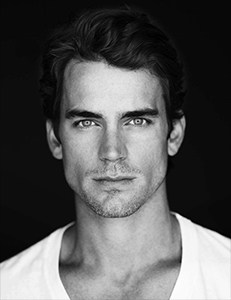
Facial structure and proportions also come into play. An attractive masculine face is one in which each feature harmonizes with the rest of the face. Balance and proportion in the face are incredibly crucial for attractiveness.
However, many male models are not masculine at all and veer more to the androgynous prettyboy side of the equation. Many male models are actually quite androgynous, such as Michael Tintiuc:
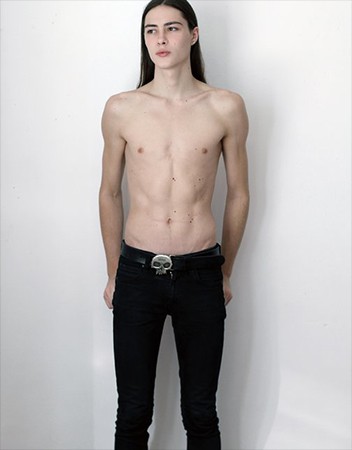
Check out our YouTube channel for an in-depth discussion of masculine vs. prettyboy aesthetics.
Height and Body Proportion
Height is a significant and vital aspect of modeling. Across different places and cultures, the height factor might differ considerably. But one thing remains certain: male models are tall. What tall means may be subjective and difficult to quantify; however, according to New York’s Better Business Bureau, male models for high fashion range from 5’9″ to 6’2″. Of course, models that are TOO tall are undesirable as well. The key is to achieve somewhat of a middle ground.
Body proportion should also be well-balanced. Male models should have long legs because long legs aid in the perception of gracefulness and help with posturing. Because modeling is mostly a visual career, the perception of the audience is essential. The male model should carry himself with grace and elegance.
This study by Fan et al. (2005) analyzed three male body parameters in relation to attractiveness. Among the three, the most important visual cue is that of the Volume-Height Index. This information is telling of how vital proportion and height are when talking about ideal attractiveness. The model needs to be tall, but he also has to have a body that is proportionate to this height. This balance is critical.
For more information on ideal male body aesthetics, check out our in-depth guide.
Facial Structure
Facial structure is altogether a different story. The male model look is quite a distinct flurry of sharp angles and notable features. For men, this means that the jawline and the chin should be well-proportioned and accentuated nicely.

This image showcases masculinity on the left and androgyny on the right. Notice that as we go from right to left, the subject’s jaw becomes more pronounced, and the chin becomes wider. The neck also increases in size. Just these things alone help greatly in creating a masculine look. The androgynous subject’s slightly soft and feminine looking features become sharper counterparts the more you go to the left.
The more the subject gains hollow cheeks, the more masculine they become. Click here to see our hollow cheek guide.
Also, the subject’s brows and eyes look more intense. On the right, the subject’s eyes are larger and similar to that of a doe. This is a feminine trait and gives off the impression of innocence and youth. Masculinity is the opposite of that. That’s why intensifying the brows and eyes gives a more masculine vibe. Eyebrows frame the face, and the eyes are the most expressive parts of the face. For a guide on how to get more attractive eyes, check out our in-depth guide here.
There’s also a nose. One of the most prominent things on a face is the nose. In many cases, this will be the focal point of the face. Having a nose that is the right size and proportion to the rest of your face is vital in getting that overall male model look. Visit our in-depth nose guide here.
How to Achieve an Ideal Male Model Look
Even though genetics and bone structure play a large part in determining whether a man has successful male model characteristics, you can still get outside help.
Weight Loss
The first and most obvious is to get fit. Male models look fit and lean, whether they are slender or muscular. They look healthy and not overweight or spindly. Exercising has many health benefits, as well. No male model looks the way they do by binge eating unhealthy food and not getting enough exercise. It takes work to achieve that picturesque body and frame.
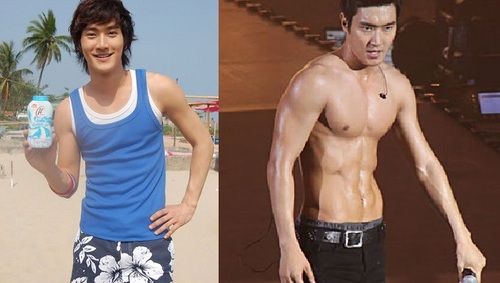
The photo above shows Choi Siwon, a South Korean model, known for being a member of the boy band Super Junior. In the left picture, Siwon looks a bit spindly and skinny. His facial features are soft and sort of feminine. However, when he bulked up and got leaner, it also transformed his face and made it sharper. The overall effect of these changes in Siwon was terrific and elevated his appearance.
Mewing
Of course, even if you are already fit and lean, you should still be mewing anyway. Mewing will improve your jaw, chin, and make you look more defined. It could even help you achieve that hollow cheek look that many male models have. For more info on mewing, visit our Ultimate Guide.
Even in adults, mewing, when done right, can have significant effects. Although, of course, mewing works best at younger ages. Over time, the bones of the face can still change but lose much of their flexibility over a certain age. This reduced flexibility may be one of the things you have to consider with mewing. Given that, it is still a viable option if you want to achieve that signature jawline and coveted cheek hollow that many male models sport. For more information on how to get a better jawline, our other article may help you.

This image shows a before and after of mewing of YouTuber AstroSky. He achieved drastic changes in the jawline, cheekbones, and eyes.
Conclusion
To sum it up, ideal male model characteristics vary over time and place. However, certain traits are timeless and are globally recognized to be modelesque. One such example is a striking jawline. Male models all over the world sport a prominent jawline and chin. The lower third adds to their overall appeal and attractiveness. Another one of these traits is the hollow cheek look. But your cheeks should not appear unnatural or unhealthy looking.
Of course, height is also of utmost importance. Too tall or too short, and you’re much less likely to land a modeling gig. This male model characteristic is prominent in all parts of the world.
The idea with model characteristics is that they are sharp and unique but not extreme to the point of undesirability. How much of an ideal male model you look is partly up to genetics and bone structure, but it is also up to you.


